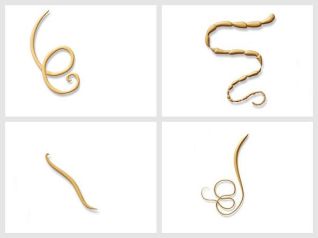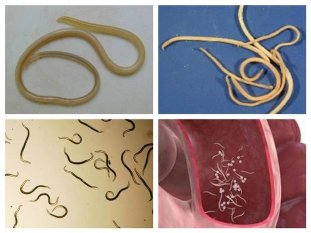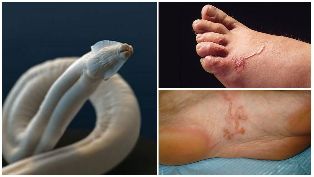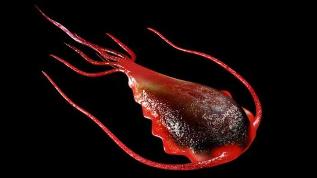Every day the helminth infected adults and children, from this you can protect yourself, but it does not always work. Therefore, in order to understand clearly that there is, you need to know their species. Because only correctly identifying helminthic, you can win.
In this article you will learn about: what are human we are the worms, where it is possible to collect specific signs of infestation. Take care of your health and remember that You have one.

Human worms — classification
Helminths (worms) – large class of parasitic worms which live in the body of the people, animals and plants. Helminths, worms-parasitic, feeding on the internal resources of the organism, the "host" not only weaken the body, but also promote the development of other concomitant diseases.
Strangely enough, but almost every other person – the support of a species of helminths and not even noticing, until you have complications or not there will be a further examination. Depending on the climatic zones, in different territories, continents, living in different worms.
The helminths are classified according to the method of transfer from body to body:
- bio helminth – transmitted from animals;
- contagious – it is transmitted from a sick person;
- geo-helminth – larvae are stored in the soil.
In case of contact with the larvae in the body, they move through the body with a current of blood and are deposited in the organs. Often helminths will settle in the different departments of intestine. The classification of the place of settlement of parasites:
- Translucent helminth – settle in the hollow organs.
- Fabric – are hosted in the tissues.
- Others can live, and in the hollow organs, and in the thickness of the tissues.
In nature, there are about 250 species of helminths. For each of them are necessary some conditions for their existence and development. The worms differ in size, shape, and other characteristic signs.
The classification of these parasites is still up to the end are not formed and approved by the scientists.
The division of the worms on a territorial basis has also put in place. This fact complicates the classification of parasites. In the countries of the mid-latitudes with moderate weather conditions it can count more than 20 types of worms that are divided into three groups depending on the appearance and form:
- Round (nematodes);
- Band (cestody);
- Flat (flukes).
Nematodes and flukes is more common in nature, rather than the band parasites. The human body – the ideal environment for the reproduction and growth ossiuri, and roundworms. In addition, you can often meet and trichinella. In the tapeworms belong bull, pig, rat taenia, a tapeworm.
Species of helminth man — nematodes (nematodes)
Another name of these nematodes. This type of helminth is considered to be the most common. They are characterized by a round shape of the body in cross-section. The body length in several species of worms can vary from 5 mm to 40 cm.

For the life of usually the intestine, but it is fairly easy to migrate to the host body can live in other organs.
The wide distribution of nematodes due to the fact that the infection from them is very easy. Intermediate host is not necessary, and are passed from one browser to another. Also the infestation can develop eating dirty fruit or vegetables. This is why the infection these helminths are the children, because they are prone to violate the rules of hygiene.
Ossiuri
Ossiuri – representatives of the nematodes, they have a round shape, with a length of about 2 inches. Meet between adults and children. They live in the small intestine and develop from the stage of the larvae prior to adult for 2 weeks. Ossiuri cause the disease enterobiasis.
The infection Enterobius is manifested with inflammation of the intestinal wall, are violated in the digestive processes, toxins worms cause local hemorrhage. The disease manifests itself in the evening itching in the anus. Itching cause the females that lay the eggs.
They are infected with Enterobius not only in case of contact with common objects with an infected person, but also through the vegetables in the garden (the eggs are stored in the soil), cockroaches, and flies — carriers of the eggs of the worms. For the enterobiosi women parasites can cause inflammation of the genital organs. Also become inflamed and scratches, which leads to the aureus.
Worm
Worm – nematode, growing up to 40 cm and a diameter of about 6 inches. Eggs of ascaris in case of contact with the ground can be stored for about a year before falling into a favorable environment for development. When the larva worm enters the body of the support, and begins to develop, highlights the toxins that affect the lungs, the liver.
The larvae travel throughout the body and affects the blood vessels and causes inflammatory foci. Justified in the intestines and lives on his own content. Per day may defer to a couple of thousands of eggs.
Thanks to its remarkable size worm in search of food can move to the pancreatic duct, the bile ducts of the liver, and trigger the inflammatory process in the intestine, they can go into the esophagus and block the airways. Causes this disease, as the ascaridiosi.
Find the worm in the body, it is possible to recognize the symptoms:
- Nausea and vomiting, abdominal pain.
- Fatigue.
- Diarrhea, red worms in the stool.
- Allergic reactions.
Roundworms have the property to coagulate in a tangle, when there is an intestinal obstruction, and peritonitis.
Trichuris trichuris
The representative of nematode trichuris trichuris. Length – 5 cm. You form a fundamental part thin, and a short wide. The presence in the human body lander module may cause trihozefalez.
The presence in the body of the lander module port trichocephalosis and manifests the symptoms:
- abdominal pain, decreased appetite;
- the diarrhea changes, and constipation;
- sometimes the admixture of blood in the stool;
- iron-deficiency anaemia.

Toxocara
This type of nematode live in the stomach of dogs, and with the feces the eggs fall on the ground. An external parasite similar to ascaris, but only grows up to 15 centimeters. The entire life cycle of the parasite takes place in the body of a dog, then get in a favorable environment of man, the larvae die, but the time in this evil.
Affect the muscles, the liver, the lungs, the heart, the tissues of the eyes, the brain, the disease develops toxocariosi.
The activity of the larvae in the body manifests itself with these symptoms:
- the increase of the temperature;
- the increase of the lymph nodes and the liver;
- eruption on the skin;
- pulmonary infiltrates;
- shortness of breath, dry dyspnea, cough;
- a disorder of the psyche, and seizures.
- the analysis of the blood showed the presence of eosinophils.
To confirm the diagnosis is possible with the help of a scrub the affected area of the skin, blood tests for antibodies, liver biopsy.
Ancylostoma
In this case, the infection occurs through the skin or by ingestion of larvae. With the blood may be in the lungs and the heart, but prefer the small intestine. They live about 4 years, causing hookworm. Symptoms:
- Fever.
- Increased salivation.
- Eosinophilia.
Manifestations of disease occur in the execution stage infestations, when in the body accumulates a large number of worms. The initial phase is asymptomatic, they can locate the pathology in a random manner.
Tapeworms (cestody)
If you study all the varieties present in humans the worms, then tapeworms are the most hazardous. The main risk associated with the size, because this type of parasites can reach a length of 18 m.
Because of this, their effect on the human body is very unfavorable. The complete cycle of their life requires the change of host. A certain part of it tapeworms live in the body of cattle, from which they pass to the people.
A tapeworm
A tapeworm can reach up to 10 metres in length. With the help of the slots on the head attaches to the surface of the intestine. In the human body comes with raw, fresh water fish in the form of larvae and develops fully within a month.
Symptomatic the presence of the parasite in the body it manifests itself like this:
- beri-beri deficiency of vitamin B12, folic acid;
- vomiting, nausea, diarrhea;
- disorders of the functions of the gastro-intestinal tract;
- the exhaustion of the body;
- the increase of the temperature.
This parasite is nourished by absorption of nutrients to the surface of the whole of his considerable body. In a place to anchor to lentetsa develops necrosis. In calais appear to be members (they contain eggs) the worm and its egg.

Toro tapeworm
Toro tapeworm (exemplary) lives in the small intestine and reaches 7 metres in length. The larvae of the tapeworm bovine infect humans through the consumption of poorly cooked beef. The larvae easy to see in the flesh, as well as their size is approximately 5 mm. to Enter in a man's body, the larva develops for 3 months.
Multiply with the help of segments, which contain up to 150 thousand larvae. These segments on the body of a bull tapeworm about 2 thousand.
These members of car come out at night from the anus and apply to the bed. The presence of this worm may lead to disease beef tapeworm infection, which manifests with the symptoms:
- The exhaustion of the body.
- Disorder of the bowel.
- Loss of appetite, nausea, vomiting.
- Allergic reactions.
Pork tapeworm
Pork tapeworm can be confused with a bullish, but what are the dimensions of a modest 2.5 meters. And the number of segments of this parasite is even smaller-about 1 thousand. Head screw equipped with a suction cup, and a proboscis with hooks that secure it to the thicker of the intestines.
Can be infected through undercooked meat and fat. This parasite causes diseases taeniasis and cysticercosis. The symptomatology depends on the amount of worms in the body. A large number of parasites can cause an intestinal blockage, which is treated only surgically.
Hookworms
Is the causative agent in hookworm. Habitat – 12-earth, the intestine. Length-worm of about 14 millimeters. It feeds at the expense of nutrients, which produces from the intestinal wall.
Parasite through the blood vessels affects the liver, the lungs, the heart. The infection hookworm duodenal ulcer is manifested by these symptoms:
- belching, nausea, heartburn, stomach upset, vomiting, diarrhea;
- headache, dizziness;
- cough, asthma, pneumonia, pain in the heart;
- fatigue, chronic fatigue.
Hookworm causes complications: hepatitis, ulcer duodenal ulcer 12, bronchitis, laryngitis, endocarditis. Make sure the diagnosis is possible with the help of blood tests, fluoroscopy, x-ray.
Simple organisms
Protozoa are called for what they are unicellular. But this does not mean that their presence in a man's body should not be a cause for concern. When these types of pests that can occur in not less serious than the disease, that in other cases.
Giardia
Their dangerousness is linked to the fact that in the presence of the body lack of pathological manifestations. The people infected by these microorganisms, that swallows the giardia cysts. This can happen when you swim in open water. Playing them is done by splitting the cells in half.
From the stomach, these parasites are recorded in the whole of the body together with the blood, which affects a variety of organs.
The patient may notice the symptoms of all types of diseases, but not to guess the reason for their development. Often giardiasis causes the following diseases:

- The allergy.
- Bronchitis.
- The bronchial asthma.
- Dermatitis.
- Cholecystitis.
- VSD.
- Enterocolitis.
- The dyskinesia 12 duodenal ulcer and bile ducts.
- Enteritis.
- The chronic fatigue.
Further progression giardiasis can be a cause of diseases of the central nervous system and the circulatory system.
The symptoms of worms
The event helminthiasis people can vary. The symptoms that occur in people who have a strong infection:
- Look painful.
- The loss of weight.
- Pallor.
- Itching in the anal area.
In most cases, the infection helminths has a similar symptoms with other diseases, the treatment of which does not give the effectiveness. Depending on the place of localization of parasites and their number occurs, the development of specific symptoms.
Non-functioning of the gastrointestinal system
If the helminth parasites in the gut, then the man is faced with these problems, such as:
- Diarrhea, or conversely constipation.
- Nausea and vomiting.
- Pain in the area of the intestine.
- The swelling.
- Heavy loss, or, on the contrary, the increase of weight.
Large worms may overlap the intestine, and become the cause of constipation. Because of the constant selection of the waste products, the person feels all the signs of intoxication – nausea, vomiting, general weakness.
Prevention

You must remember that there are the worms cannot multiply in the human body, each species has its period of time, after which they are killed, for example, ossiuri is only a couple of weeks, ascaris about a year.
Deferred from the adults to the eggs, they must necessarily leave the body with the faeces or on the skin near the anus, in the external environment, the ground, and only then, cos outside of the human body and enter into him, once again, begin to stir and parassitano.
Why multiply in the human body, the worms may not, increase in the number of adult individuals in the gut already infected person, which can only be a result of infection, when the eggs are again enter the body through the mouth.
For example, a person might get rid of the worms after 3-4 weeks without any treatment. But it is not so easy to enforce these rules to the children and school-age children.



































